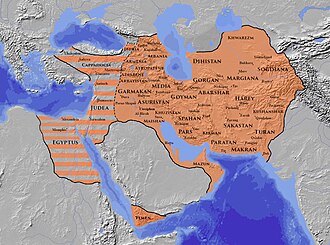Roman–Iranian relations
Roman–Iranian relations refer to the historical, political, military, and cultural interactions between the Roman Empire and the various states of Iran, primarily the Parthian Empire and the Sasanian Empire. These relations spanned over several centuries, beginning in the 1st century BC and lasting until the Muslim conquests of the 7th century AD, marking one of the longest and most complex rivalries in ancient history.
Background
The first significant contacts between Rome and the Iranian states began in the late Republic period, with the expansion of Roman power into the Eastern Mediterranean and the simultaneous rise of the Parthian Empire as a major power in Iran. This period set the stage for several centuries of political and military confrontations, interspersed with periods of peace and diplomacy.
Parthian Period
The Parthian Empire, established in the mid-3rd century BC, was Rome's first major Iranian adversary. The most notable conflicts between Rome and Parthia included the Battle of Carrhae in 53 BC, where the Roman general Crassus was defeated, and the Parthian campaigns of Mark Antony in 36-34 BC, which ended in failure for the Romans. Despite these hostilities, there were also periods of peace and alliance, such as during the reign of Augustus, when diplomatic relations were established.
Sasanian Period
The rise of the Sasanian Empire in AD 224 marked a new phase in Roman-Iranian relations. The Sasanians, under rulers such as Shapur I, were more aggressive in their expansionist policies than the Parthians, leading to several significant wars with Rome. The most famous of these conflicts include the Roman-Sasanian War of 244-249, where Emperor Gordian III was killed, and the war of 260, which saw Emperor Valerian captured by Shapur I. The conflict culminated in the 6th and early 7th centuries with the Byzantine-Sasanian wars, notably under the reigns of Justinian I and Khosrow II, which exhausted both empires and made them vulnerable to the emerging Islamic caliphates.
Cultural and Economic Exchanges
Despite the frequent conflicts, Roman-Iranian relations were also characterized by significant cultural and economic exchanges. The Silk Road, a network of trade routes, facilitated the exchange of goods, ideas, and technologies between the Roman and Iranian worlds, influencing various aspects of society, from art and literature to religion and technology.
Impact and Legacy
The long history of Roman-Iranian relations had a profound impact on the development of both civilizations and their respective cultural and political legacies. The rivalry pushed each empire to military and administrative innovations, while the periods of peace and trade contributed to economic prosperity and cultural exchange. The legacy of Roman-Iranian relations is evident in the continued interest in and study of ancient Near Eastern and Mediterranean history.
See Also
Transform your life with W8MD's budget GLP-1 injections from $125.
W8MD offers a medical weight loss program to lose weight in Philadelphia. Our physician-supervised medical weight loss provides:
- Most insurances accepted or discounted self-pay rates. We will obtain insurance prior authorizations if needed.
- Generic GLP1 weight loss injections from $125 for the starting dose.
- Also offer prescription weight loss medications including Phentermine, Qsymia, Diethylpropion, Contrave etc.
NYC weight loss doctor appointments
Start your NYC weight loss journey today at our NYC medical weight loss and Philadelphia medical weight loss clinics.
- Call 718-946-5500 to lose weight in NYC or for medical weight loss in Philadelphia 215-676-2334.
- Tags:NYC medical weight loss, Philadelphia lose weight Zepbound NYC, Budget GLP1 weight loss injections, Wegovy Philadelphia, Wegovy NYC, Philadelphia medical weight loss, Brookly weight loss and Wegovy NYC
|
WikiMD's Wellness Encyclopedia |
| Let Food Be Thy Medicine Medicine Thy Food - Hippocrates |
Medical Disclaimer: WikiMD is not a substitute for professional medical advice. The information on WikiMD is provided as an information resource only, may be incorrect, outdated or misleading, and is not to be used or relied on for any diagnostic or treatment purposes. Please consult your health care provider before making any healthcare decisions or for guidance about a specific medical condition. WikiMD expressly disclaims responsibility, and shall have no liability, for any damages, loss, injury, or liability whatsoever suffered as a result of your reliance on the information contained in this site. By visiting this site you agree to the foregoing terms and conditions, which may from time to time be changed or supplemented by WikiMD. If you do not agree to the foregoing terms and conditions, you should not enter or use this site. See full disclaimer.
Credits:Most images are courtesy of Wikimedia commons, and templates, categories Wikipedia, licensed under CC BY SA or similar.
Contributors: Prab R. Tumpati, MD






